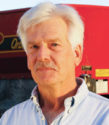Advertise Follow Us
Articles Tagged with ''Iowa''
Cover Crops
Buffering the Soil with Long-Term Cover Cropping
Jeff Olson is protecting soil and improving water infiltration with a mixed bag of application methods and plenty of patience.
Read More
Who Makes the Best No-Till Planter?
Readers weigh in on their favorites, and their favorite modifications to their favorites
Read More
Landowner Perspective
A Landowner's Responsibility
All of society has an interest in the land used for our food production and recreation, and therefore the owners and renters have a responsibility to treat it in the best possible manner.
Read More














